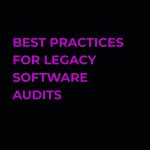Introduction
Imagine your business as a car. If you’re still driving a model from the 1980s, it might be time for an upgrade. Like cars, software needs to evolve to keep up with the times. Legacy software, outdated and often inefficient, can drag your business down. It’s time to hit the gas and accelerate your business growth with a legacy software upgrade.

Understanding Legacy Software
Legacy software is like that old friend you’ve had since high school. It’s familiar but might not be the best fit for your current life. These systems are often outdated, lacking essential features, and vulnerable to security threats.
The Risks of Not Upgrading Legacy Software
- Security Breaches: Outdated software is a prime target for hackers. A security breach can lead to data loss, financial damage, and reputational harm.
- Reduced Efficiency: Legacy software can be slow, inefficient, and difficult to use, hindering productivity and frustrating employees.
- Compliance Issues: Many industries have strict regulations that legacy software may not meet. Non-compliance can result in fines and penalties.
- Limited Scalability: Legacy software may need help handling growth or changes in your business, which can limit your ability to expand and innovate.
Benefits of Upgrading Legacy Software
- Improved Security: Modern software has built-in security features that protect your data and prevent breaches.
- Enhanced Efficiency: New software can streamline processes, automate tasks, and improve productivity.
- Better User Experience: Modern software is often designed to be more user-friendly, improving employee satisfaction and productivity.
- Increased Scalability: Upgrading to a modern software solution can help your business grow and adapt to changing market conditions.
- Reduced Costs: While upgrading software may involve upfront costs, the long-term benefits can outweigh the initial investment.
How to Approach Legacy System Upgrades
- Assessment and Evaluation: Conduct a thorough examination of your legacy systems to identify their strengths, weaknesses, and risks.
- Develop a Modernization Plan: Create a comprehensive plan that outlines the goals, timeline, and resources required for the upgrade.
- Choose the Right Approach: Consider replacement, modernization, or migration options.
- Address Data Migration: Develop a strategy for safely and efficiently transferring data from your legacy system to a new one.
- Prepare for Change Management: Communicate the upgrade to your employees and stakeholders and address potential concerns.
Conclusion
Upgrading your legacy software is an investment in your business’s future. By addressing security risks, improving efficiency, and enhancing the user experience, you can unlock new opportunities for growth and success. Don’t let outdated software hold you back. It’s time to upgrade and drive your business forward.
Do you remember when you last updated your business core legacy systems? Or have you had any errors recently on your systems? Then, you will need to start by doing a legacy software audit! Don’t let your business collapse within minutes because of the old, insecure legacy software systems! Click the button below to get started with legacy software audit!



